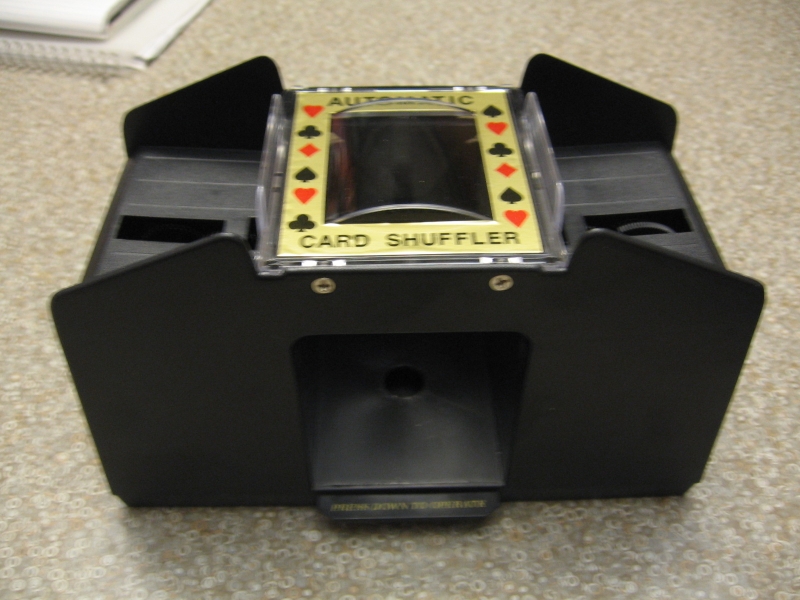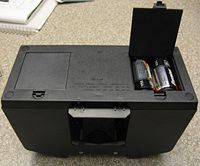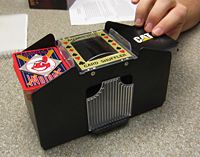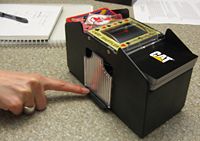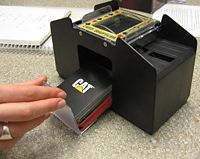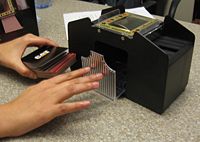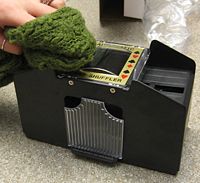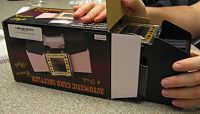Automatic card shuffler 2
From DDL Wiki
Contents |
Report 1: Product Analysis: Competitor Product Study: CHH Games 4-Deck Automatic Card Shuffler (Casino Style)
Executive Summary
Product Operation
Upon being removed from its packaging, the competitor card shuffler must be equipped with 4 C batteries (not included). Two batteries are placed in each side of the base by opening two plastic tabs that lift two flaps to reveal the respective battery locations (see image to the right). It is interesting to note that the springs for each negative terminal twist and bend, thus providing only marginal contact between them and the batteries.
After inserting the batteries and closing the flaps, the entire shuffler can then be equipped with decks of playing cards on each side of the clear plastic top. Note that according to the competitor's description, up to 2 decks can be placed on either side, though for the operation illustrated in the pictures, only one deck was placed on either side. The image to the left illustrates this first step of operation. Also, the loose clear plastic tray should be situated snugly within the alcove prior to operation of the shuffler.
To begin shuffling the decks of cards, a plate labeled "Press Down to Operate" is pushed. The plate must be held down continuously until both decks are completely processed through the shuffler. Cards are shuffled by being shot forward via a circulating wedge that is driven by the internal gears and motor. The wedge regularly breaks the surface of the deck-holding area, thrusting the card in contact with it towards a narrow crevice underneath the clear plastic top. Cards then fall onto the plastic tray. Since the wedges on either side of the card collection cache move out of sync, the cards from either deck enter at alternating times. Sporadically during any given run, some cards from either side get caught along the side walls of the collection cache and do not fall onto the other cards accumulating on the plastic tray.
Once all the cards have been thrown into the cache, removal is performed by clasping the edges of the plastic tray and sliding it out. Care has to be taken on the user's part to ensure cards in a large stack (i.e. when more than 2 decks are shuffled) are not accidentally shaken off. Once fully removed from the shuffler cache, the cards themselves can be removed from the tray and used for play. The plastic tray is then re-inserted in the cache.
Post-operation maintenance and storage is very simple. The biggest detriment to the shuffler's useful life-span is the accumulation of dust over not just the entire surface, but upon the exposed gear assemblies. Over an extended period of time, dust and dirt accumulation on the gears can lead to destruction of the teeth (exacerbated during operation while not clean), which will wear down or loosen due to the minuscule (but growing) obstructions. Therefore, some cleaning must be done regularly if the shuffler is used often (once a week, for example) and kept out in the open. A dry cloth or rag will suffice in order to remove the majority of the superficial dust. However, for long-term survival, storing the shuffler in the box that it came packaged in is a viable and cost-effective option for the user. Note that while these care and maintenance suggestions have been discussed, they are no where to be mentioned in any documentation that came with the shuffler, no doubt signaling the manufacturer's intent to merely create and sell a "bare bones" model that is intended to be thrown away upon the first failure not attributable to dead batteries.
Design For Manufacturing
This product was designed with the ease of manufacturing in mind, but it was not without flaws according to our analysis. The areas of this design done well and the potential areas to be improved are summarized below with respect to manufacturing.
Good points:
- Design is simple
- Almost every part is made out of plastic
- Almost no really tight tolerances
- Minimal secondary and finishing operations
- Color could be incorporated into injection molding since almost the entire product is black plastic
- Standard motor that could be inexpensively purchased
- Aluminum parts could be stamped and then bent to avoid costly manufacturing procedures
Areas of Potential Improvement
- High part count
- Lot of screws, no standard size between screws
- Extra gears added so that cheaper, faster motor could be used
- Almost all parts were unique, could only be used in one place
- Tolerances might have been too loose, product jammed, more precise gears might have reduced noise level
There are many areas of this design that are done well in regards to design for manufacture. The first part is that the design is fairly simple in nature, meaning that the individual parts that it consists of are no too difficult or complex. This is important because this will simplify the manufacturing of the individual parts and the overall product as a whole. Additionally, almost the entire product is made out of plastic, which makes it easier to manufacture because you could use the same plastic to make almost any part within the product. The tolerances within the product are not very tight, so precise machining or injection molding is not required. While this is an advantage for this style of design, it did become an issue in performance because the cards would sometimes get jammed or one side would not shuffle the cards with the other side, which could have been prevented if the tolerances were tighter. Another advantage is that almost the entire product is black, so the black color could be incorporated into the injection molding process, reducing the amount of secondary process such as coloring the product. The motor is a standard part, which is used in many other simple toys, can be purchased separately to decrease the amount of manufacturing necessary. Finally, the aluminum parts can easily be stamped and bent into the correct shape. This is a fairly inexpensive and quick manufacturing process compared to some of the other processes available, which will save both time and money.
Despite the many portions that were done well with regard to manufacturing, there are some definite areas for improvement. The first area is the fact that there are many parts and they are almost all unique. This will be inconvenient for manufacturing because the machines need to be changed or separate machines need to be used to manufacture each of the individual parts. Making some of the parts interchangeable may help reduce manufacturing costs. Another area that could be improved is the fact that several extra gears are used in order to facilitate the use of a cheaper motor. While this may be advantageous overall for cost effectiveness, it is not convenient for manufacturing because additional gears of different sizes need to be made to get the desired speed of the final product. Additionally, there are a lot of screws involved in fastening the product together, of which almost none of them are the same size. Most of these screws are probably purchased separately, so the burden on manufacturing is not that high, but it is inconvenient, especially because they are not all the same size. If the screws were all the same size, it would standardize the buying process and ease assembly. Finally, while the tolerances being loose is advantageous for manufacturing, the tolerances on this product might have been a little too loose because the product did jam a lot if the cards were not placed perfectly or if three or more decks were being shuffled. Tighter tolerances might have helped to have the final product function better, but it would put an additional burden on manufacturing.
